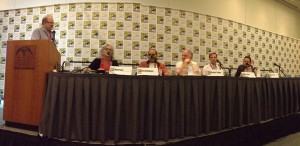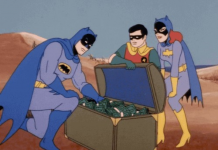By Matthew Jent
In a quiet panel room on Friday afternoon, in the far reaches of room 28, moderator Mark Waid led a panel about striking the balance between creating art that is personal and art that is strictly for hire.

The panelists were Mimi Pond, a cartoonist for the National Lampoon, Village Voice and the Los Angeles Times, as well as the New York Times-bestselling author of The Valley Girl’s Guide to Life and Over Easy; Ray Billingsley, creator of the syndicated comic strip Curtis; Michael T. Gilbert, creator of Mr. Monster; Jim Rugg, writer and artist of Street Angel and host of the BoingBoing podcast Tell Me Something I Don’t Know; and David Lasky, Eisner-winning writer and artist of Don’t Forget This Song, a graphic novel biography of the Carter Family.
Waid kicked things off with the question, “When did you first feel like a professional?”
Ray’s answer spoke to the question at the heart of the panel: it was when he got kicked out of his house at 17 and realized he could pay his rent by cartooning. Since then, he’s never had any other kind of job.
Michael’s epiphany came in a similar manner: it was when the Berkeley Bard, a small alternative paper in Berkeley, California, paid him $25 for a cartoon.
Jim’s big professional moment was a little anticlimactic. Street Angel had originally been published by SLG, and when it hit comics stands he went to his local shop.
“By the time it was on the shelf, I’d been done with it for many months,” he said, “and nobody at the store seemed to care about it. What was more exciting was when (SLG Publisher) Dan Vado would call me — I remember that, that was very exciting.”
David knew his comics career was meant to be after he’d mailed a minicomic version of James Joyce’s Ulysses into the Washington Post and, to his surprise, they reviewed it in their Sunday paper. He’d included his father’s address with the comic, and the instructions to mail in $1 and postage for more copies. After the review was published, the mailman came to his father’s door with duffle bags full of envelopes, each stuffed a single dollar bill.
Mimi’s was a little more personal: she remembered showing her Lampoon editors around at a past San Diego Comic Con, giving them directions around town.
“Not that there’s anything wrong with doing for work for hire,” said Waid, “but the commonality here is that everyone was doing their own stuff.”
“It’s all for love,” Ray said, “not for money.” He briefly worked for Disney as an animator, but he walked away from what could have been a lucrative career there. “If it inflicted on me what I didn’t want, I wouldn’t do it.”
The constant notes and edits and requests for redrawn scenes wore on him. Years later, when he was a successful syndicated cartoonist, Disney came back and asked him to draw a Mickey Mouse strip, but he still said no.
“I’ve been with you people before,” he told them. “It wouldn’t be fun.”
Mimi concurred, having spent some time working on Disney projects.
“I had storyboard artists — they could draw like angels,” she said. But when the project was shown to the executives in charge, the project was cancelled. The storyboard artists moved on to the next project-for-hire, and Mimi moved on.
“I wanted to slap them,” she said, “And ask, haven’t you ever wanted to wake up in the back of a speeding car and not know where you’re going?”
But Mimi stressed that making those choices was personal for everyone. She was married with two children, and when she found herself no longer writing for successful shows like The Simpsons and Pee Wee’s Playhouse, her husband’s income supported the family.
The panel concluded with a Q&A, much of which involved questions about how to balance living a creative life with demanding dayjobs.
“There’s no shame in taking on a second job, or some work-for-hire,” Michael said.
But the panel agreed that it was necessary to feel — and pursue — the projects and outlets that fuel your passion.
After an attempt to switch careers and become a graphic designer, David found himself back in the world of comics. “I’m happier being poor and making comics,” he said.
Jim Rugg stressed that it was possible to have a fulfilling creative and business life. After Jim quit his dayjob in 2007 to be a fulltime freelancer, the financial collapse of 2008 caused his contracts to dry up. He took a course with Creative Capital that taught better business practices to artists. “It changed everything on the financial side of what I do, with no adjustment on the creative side,” he said. He stressed the importance of making the art you wanted to make, then finding the right publishing or editorial partners.
“Your art is your commodity,” he said. “That’s where your value lies.”







